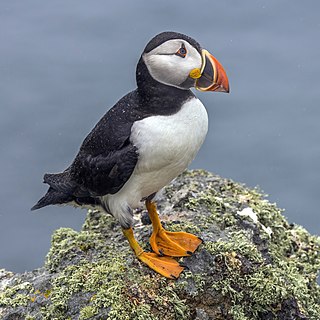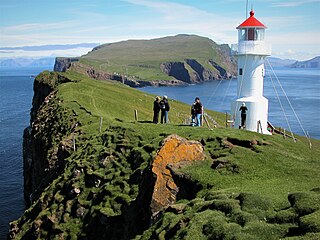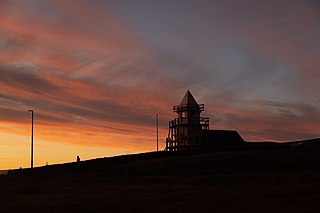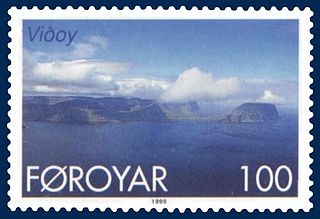
The kittiwakes are two closely related seabird species in the gull family Laridae, the black-legged kittiwake and the red-legged kittiwake. The epithets "black-legged" and "red-legged" are used to distinguish the two species in North America, but in Europe, where Rissa brevirostris is not found, the black-legged kittiwake is often known simply as kittiwake. The name is derived from its call, a shrill 'kittee-wa-aaake, kitte-wa-aaake'. The genus name Rissa is from the Icelandic name Rita for the black-legged kittiwake.

Puffins are any of three species of small alcids (auks) in the bird genus Fratercula. These are pelagic seabirds that feed primarily by diving in the water. They breed in large colonies on coastal cliffs or offshore islands, nesting in crevices among rocks or in burrows in the soil. Two species, the tufted puffin and horned puffin, are found in the North Pacific Ocean, while the Atlantic puffin is found in the North Atlantic Ocean.

Auks or alcids are a group of birds of the family Alcidae in the order Charadriiformes. The alcid family includes the murres, guillemots, auklets, puffins, and murrelets. The family contains 25 extant or recently extinct species that are divided into 11 genera. Auks are found throughout the Northern Hemisphere.

The Atlantic puffin, also known as the common puffin, is a species of seabird in the auk family. It is the only puffin native to the Atlantic Ocean; two related species, the tufted puffin and the horned puffin are found in the northeastern Pacific. The Atlantic puffin breeds in Russia, Iceland, Ireland, Britain, Norway, Greenland, Newfoundland and Labrador, Nova Scotia, and the Faroe Islands, and as far south as Maine in the west and France in the east. It is most commonly found in the Westman Islands, Iceland. Although it has a large population and a wide range, the species has declined rapidly, at least in parts of its range, resulting in it being rated as vulnerable by the IUCN. On land, it has the typical upright stance of an auk. At sea, it swims on the surface and feeds on zooplankton, small fish, and crabs, which it catches by diving underwater, using its wings for propulsion.

The razorbill, razor-billed auk, or lesser auk is a North Atlantic colonial seabird and the only extant member of the genus Alca of the family Alcidae, the auks. It is the closest living relative of the extinct great auk.

The common murre or common guillemot is a large auk. It has a circumpolar distribution, occurring in low-Arctic and boreal waters in the North Atlantic and North Pacific. It spends most of its time at sea, only coming to land to breed on rocky cliff shores or islands.

The thick-billed murre or Brünnich's guillemot is a bird in the auk family (Alcidae). This bird is named after the Danish zoologist Morten Thrane Brünnich. The very deeply black North Pacific subspecies Uria lomvia arra is also called Pallas' murre after its describer.

The black-legged kittiwake is a seabird species in the gull family Laridae. This species was first described by Carl Linnaeus in his landmark 1758 10th edition of Systema Naturae as Larus tridactylus. The English name is derived from its call, a shrill 'kittee-wa-aaake, kitte-wa-aaake'. In North America, this species is known as the black-legged kittiwake to differentiate it from the red-legged kittiwake, but in Europe, where it is the only member of the genus, it is often known just as kittiwake.

Mykines is the westernmost of the 18 main islands of the Faroese Archipelago.

Grímsey is a small Icelandic island, 40 kilometres off the north coast of the main island of Iceland, where it straddles the Arctic Circle. Grímsey is also known for the puffins and other sea birds which visit the island for breeding.

Viðoy is the northernmost island in the Faroe Islands, located east of Borðoy to which it is linked via a causeway. The name means wood island, despite the fact that no trees grow on the island; the name relates to the driftwood that floats in from Siberia and North America.

Funk Island is a small, barren, isolated, uninhabited island approximately 65 kilometres (40 mi) northeast of Musgrave Harbour, Newfoundland, Canada.

Prince Leopold Island is an island in the Qikiqtaaluk Region of Nunavut, Canada. It is located in Lancaster Sound at the junction of Prince Regent Inlet and Barrow Strait. Somerset Island is situated 13 km (8.1 mi) to the southwest; Port Leopold, an abandoned trading post, is the closest landmark. The island is significant as a summer habitat and breeding ground for large populations of several arctic bird species.

Chamisso Wilderness is a 455-acre (184 ha) wilderness area in the U.S. state of Alaska. It was designated by the United States Congress in 1975.

Witless Bay Ecological Reserve is an ecological preserve close to St. John's, Newfoundland and Labrador, Canada. The Witless Bay Ecological Reserve consists of four islands: Gull Island, Green Island, Great Island, and Pee Pee Island. Immense numbers of birds nest on these islands during the seabird breeding season, roughly from 1 April through 1 September.

A bird colony is a large congregation of individuals of one or more species of bird that nest or roost in proximity at a particular location. Many kinds of birds are known to congregate in groups of varying size; a congregation of nesting birds is called a breeding colony. Colonial nesting birds include seabirds such as auks and albatrosses; wetland species such as herons; and a few passerines such as weaverbirds, certain blackbirds, and some swallows. A group of birds congregating for rest is called a communal roost. Evidence of colonial nesting has been found in non-neornithine birds (Enantiornithes), in sediments from the Late Cretaceous (Maastrichtian) of Romania.
Baccalieu Island Ecological Reserve is a wildlife reserve located on an island off the northeastern tip of Bay de Verde Peninsula of Newfoundland.

Gjesværstappan is a group of high, steep-sided, grass-covered islands which are located north of the island village of Gjesvær in Nordkapp Municipality in Finnmark county, Norway. The three main islands are Storstappen, Kjerkestappen, and Bukkstappen.
The Runde Ramsar Site is a Ramsar Convention area consisting of five previously approved protected areas in the municipalities of Herøy and Ulstein in Møre og Romsdal county, Norway. The area was established in 2013.





















